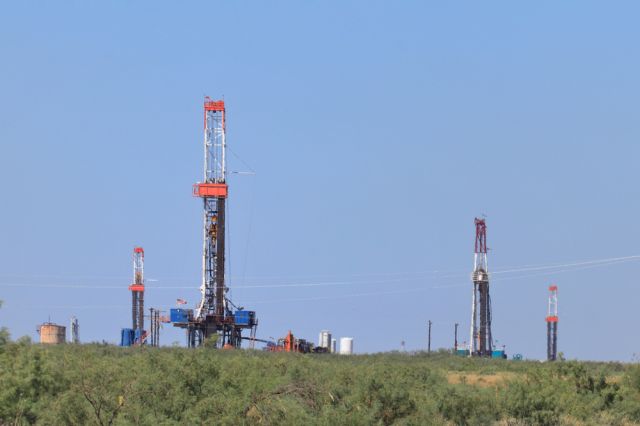
Vital Energy anticipates making 42 double-long, horseshoe-shaped wells where straight lines would have made 84. (Source: Shutterstock)
Vital Energy’s first three horseshoe-shaped wells in the Midland Basin are indicating the operator can pare 82 one-mile-lateral locations to 42, executives told investors May 9.
“Effectively, it's cutting those costs in half,” Kyle Coldiron, Vital vice president, new well delivery, said in an earnings call.
“So you’re able to spend more time drilling productive rock in the lateral and spending your dollars there as opposed to spending dollars to get to that point.”
The U-shaped laterals are planned for leasehold where Vital’s position is trapped by only one section or by offset operators.
The savings come from making one pad, one wellhead, one vertical, one lateral, one completion and one of other types of infrastructure at the lease.
Making 42 double-long U wells rather than 84 wells in the locations that Vital has already picked for horseshoes will save $140 million and reduce the per-well breakeven by $20 per bbl, said COO Katie Hill.
Delaware reference
The three wells are in Texas’ Upton County, just south of Midland County.
“This converted what would have been six 6,500-foot laterals into three extended laterals averaging close to 14,000 feet of lateral length per well,” Hill said.
Each is being completed now.
The internal go-ahead on taking the tack with these—and now with 84 other locations—is based on Vital’s completion of two U-shaped wells in the Delaware Basin that were drilled before Vital bought the property.
The wells, in the Teller unit in Reeves County, Texas, have been online for eight months. Each IP’ed an average of 1,550 bbl/d.
Results to date show 45% more output than neighbors’ wells, Vital reported.
“The Teller success … gave us confidence to expand this design in the Midland Basin,” which is Vital’s traditional operating area before recently adding a Delaware position.
Jason Pigott, president and CEO, said the go-ahead is also based on results from 43 U-shaped wells that other operators have drilled.
“We have not seen any kind of production degradation associated with the shape,” he told investors.
Two-section horseshoes?
A securities analyst on the call asked if Vital would make U wells on any of its two-section leasehold, thus 20,000-plus-ft horseshoe wells.
“The team is always thinking about creative opportunities to do something like that,” Coldiron said.
“There have been situations where we've been locked in with a land position where we've considered those types of creative opportunities.
“But it's just something that we have to evaluate on a case-by-case basis.”
Pigott added, “You need to consider the risk, too, and too much capital being invested in any one well.”
But, “this is our first shot at it,” he said. “So I think there's going to be lots of opportunities in the future.”

Locations
While future well location inventory would decline by halving the 84 locations to 42, Pigott expects the U option could result in “creating new inventory that we haven't counted before.”
Of the 84 well locations, two-thirds are in the Midland Basin—the balance, in the Delaware.
The ratio is because most of Vital’s leasehold is in the Midland, rather than a reflection of geo-mechanical qualities of the two basins.
It’s where “you have a set of wells trapped because you've got development on either side,” Pigott said.
“What we're excited about is that we have now demonstrated that this opportunity can be done on the Delaware side and the Midland side, which really unlocks the opportunity for us across our portfolio,” Coldiron said.
He added, “We think of them as being as efficient at draining the reservoir as a straight, long lateral would be.
“The benefit really comes from the saved capital that you get by not drilling six wells and only drilling three effectively.”
Recommended Reading
Buying Time: Continuation Funds Easing Private Equity Exits
2025-01-31 - An emerging option to extend portfolio company deadlines is gaining momentum, eclipsing go-public strategies or M&A.
Phillips 66’s Brouhaha with Activist Investor Elliott Gets Testy
2025-03-05 - Mark E. Lashier, Phillips 66 chairman and CEO, said Elliott Investment Management’s proposals have devolved into a “series of attacks” after the firm proposed seven candidates for the company’s board of directors.
Waterous Raises $1B PE Fund for Canadian Oil, Gas Investments
2025-04-01 - Waterous Energy Fund (WEF) raised US$1 billion for its third fund and backed oil sands producer Greenfire Resources.
Phillips 66’s NGL Focus, Midstream Acquisitions Pay Off in 2024
2025-02-04 - Phillips 66 reported record volumes for 2024 as it advances a wellhead-to-market strategy within its midstream business.
Chevron to Lay Off 15% to 20% of Global Workforce
2025-02-12 - At the end of 2023, Chevron employed 40,212 people across its operations. A layoff of 20% of total employees would be about 8,000 people.
Comments
Add new comment
This conversation is moderated according to Hart Energy community rules. Please read the rules before joining the discussion. If you’re experiencing any technical problems, please contact our customer care team.





